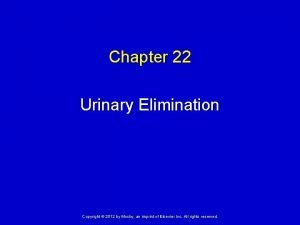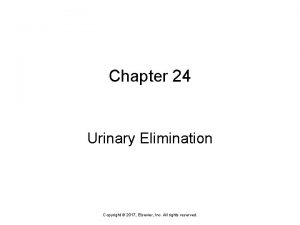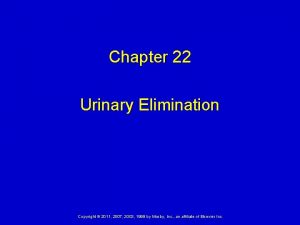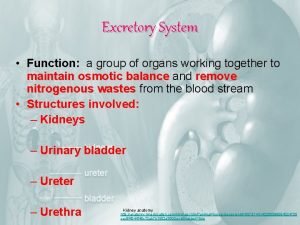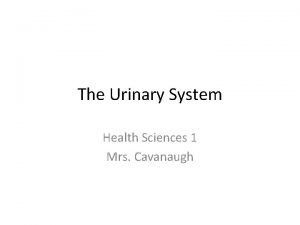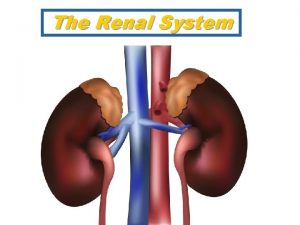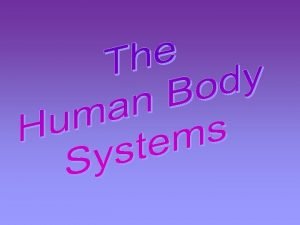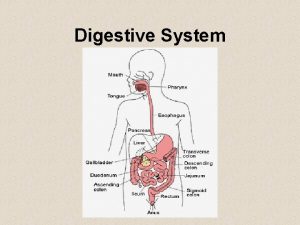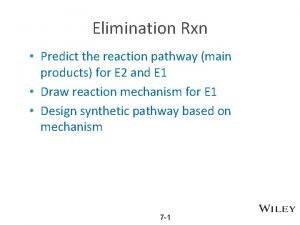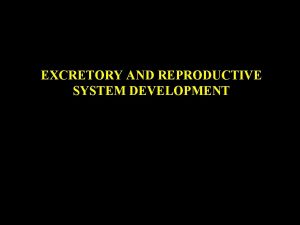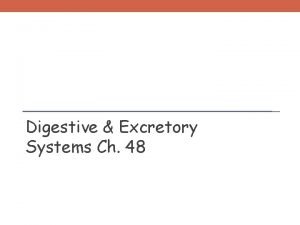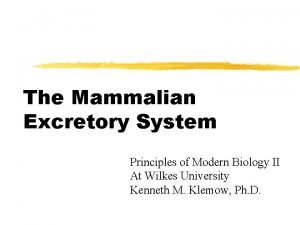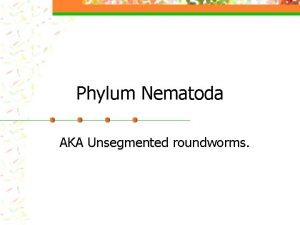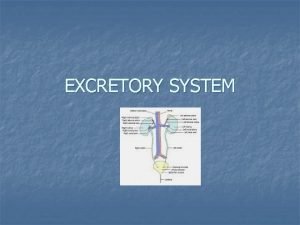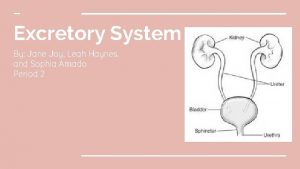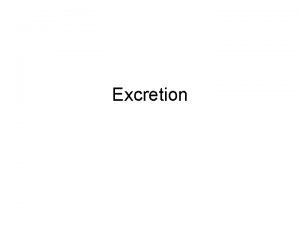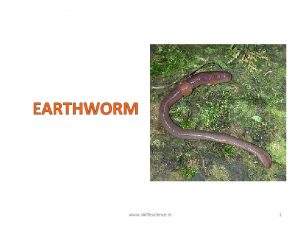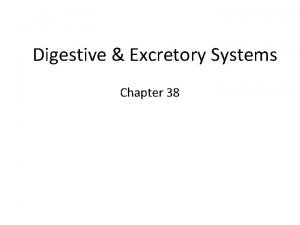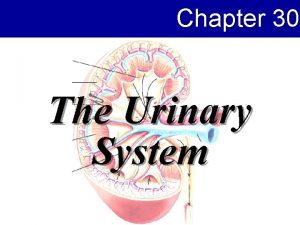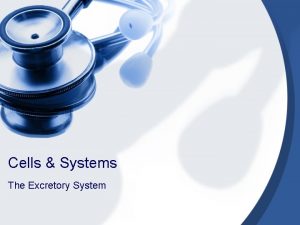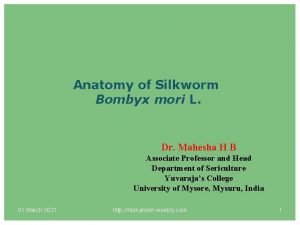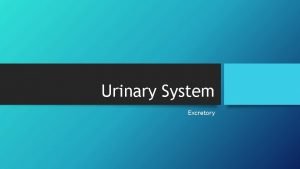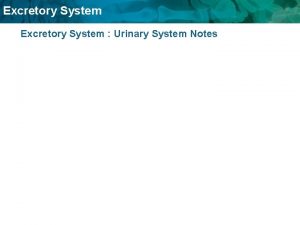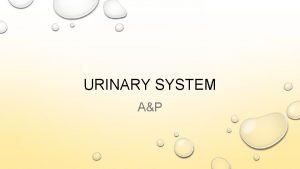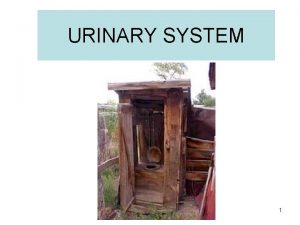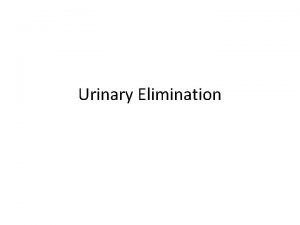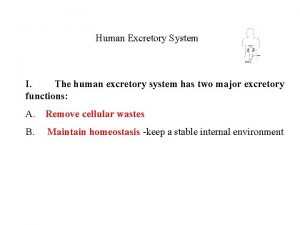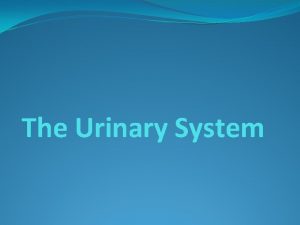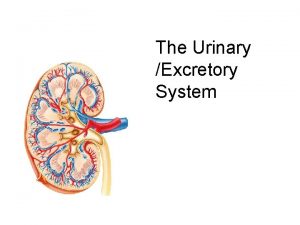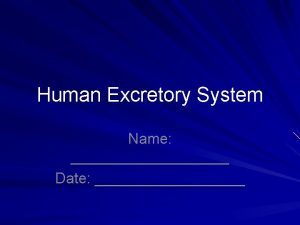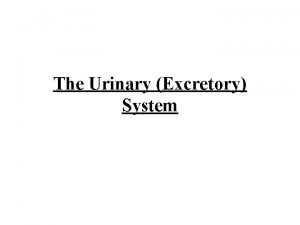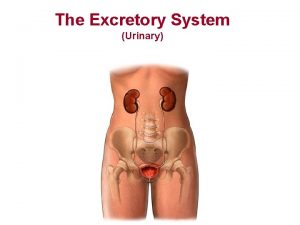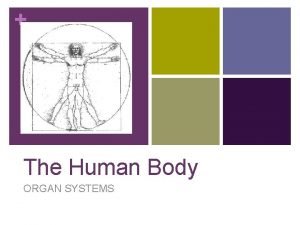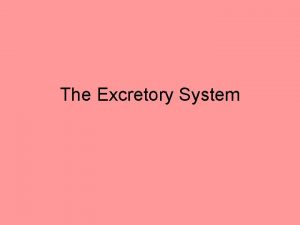EXCRETORY PRODUCTS AND THEIR ELIMINATION Human Urinary System





































- Slides: 37

EXCRETORY PRODUCTS AND THEIR ELIMINATION

Human Urinary System


IN HUMANS, THE EXCRETORY SYSTEM CONSISTS OF A PAIR OF KIDNEYS ONE PAIR OF URETERS, A URINARY BLADDER AND A URETHRA.


HUMAN KIDNEY


KIDNEYS ARE REDDISH BROWN, BEAN SHAPED STRUCTURES SITUATED BETWEEN THE LEVELS OF LAST THORACIC AND THIRD LUMBAR VERTEBRA CLOSE TO THE DORSAL INNER WALL OF THE ABDOMINAL CAVITY.

Kidney The kidney contains more than a million filtering units, or nephrons , consisting of the glomerulus, Bowman's capsule, and the loop of Henle. Blood flows through the glomerulus - a tight knot of fine blood vessels from which water and metabolic wastes filter into the tubule. This filtrate flows through the convoluted tubule and loop of Henle where most of the water and useful molecules are reabsorbed into the blood capillaries. The waste materials are passed to the collecting tubule as urine


NEPHRON

STRUCTURE OF A NEPHRON : - A nephron has two parts namely : (i) the glomerulus. (ii) the renal tubule. NEPHRON RENAL TUBULE HENLE’S LOOP 1. Descending limb. 2. Ascending limb. GLOMERUL US DISTAL TUBULE 1. Distal convoluted tubule. 2. Collecting tubule. 3. Collecting duct. PROXIMAL TUBULE 1. Bowman’s capsule. 2. Proximal convoluted tubule.

The nephron is the functional unit of the kidney, responsible for the actual purification and filtration of the blood. About one million nephrons are in the cortex of each kidney, and each one consists of a renal corpuscle and a renal tubule which carry out the functions of the nephron


NEPHRON The nephron is a tube; closed at one end, open at the other. It consists of a: • Bowman's capsule. Located at the closed end, the wall of the nephron is pushed in forming a double-walled chamber. • Glomerulus. A capillary network within the Bowman's capsule. Blood leaving the glomerulus passes into a second capillary network (not shown in the figure) surrounding the • Proximal convoluted tubule. Coiled and lined with cells carpeted with microvilli and stuffed with mitochondria. • Loop of Henle. It makes a hairpin turn • Distal convoluted tubule, which is also highly coiled and surrounded by capillaries. • Collecting tubule. It leads to the pelvis of the kidney from where urine flows to the bladder and, periodically, on to the outside world.




CORTICAL NEPHRON


-There are 2 types of nephrons based on their position in the kidney; they are as follows : JUXTAMEDULLARY NEPHRONS - Their glomeruli are placed closed to the inner margin of the cortex. CORTICAL NEPHRONS - Their glomeruli are present in the outer cortex. - They have long loops of Henle. - They have short loops of Henle. - The Henle’s loops are found deeper in the medulla. - The Henle’s loops extend only to a short distance in the medulla. - Vasa rectae are present. - Vasa rectae are absent/very few. - They are less common (15% of nephrons). - They are more common (85% of nephrons).

NEPHRON Re-absorption and Secretion of Major Substances at Different Parts of the Nephron…



URINE FORMATION. . .

IT INVOLVES THREE MAIN PROCESES NAMELY, GLOMERULAR FILTERATION, REABSORPTION AND SECRETION, THAT TAKE PLACE IN DIFFERENT PARTS OF THE NEPHRON

1. Filtration of water and dissolved substances out of the blood in the glomeruli and into Bowman's capsule; 2. Reabsorption of water and dissolved substances out of the kidney tubules back into the blood (note that this process prevents substances needed by the body from being lost in the urine); 3. Secretion of hydrogen ions (H+), potassium ions (K+), ammonia (NH 3), and certain drugs out of the blood and into the kidney tubules, where they are eventually eliminated in the urine

5. Urine formation : - Urine formation involves 3 main processes, they are : (i) Glomeluar filtration. (ii) Reabsorption (iii) Tubular secretion. (i) Glomerular filtration : -A protein-free fluid is filteredfrom the blood of glomerular capillaries into the lumen of Bowman’s capsule. -About 1200 ml of blood is filtered by the kidneys. -The filtration is caused bythe blood pressure in the glomerular capillaries. -Filtration occurs through 3 layers, which form the filtration membrane they are : (a) Endothelium of glomerular capillaries. (b) Epithelium of Bowman’s capsule. (c ) Basement membrane between the 2 layers.

-The epithelial cells (podocytes) of the Bowman’s capsule arranged in an antricate manner to leave some filtration slits. -The blood is filtered so finely that the composition of the filtrate is very similar to plasma except for the plasma proteins. -The glomerular filtration rate is about 125 ml/min or 180 l/day. - The kidneys have a built in mechanism for the regulation of glomerular filtration rate (GER). -Juxta glomerular apparatus (JGA) is a specialised cellular apparatus located where the distal convoluted tubule passes close to the Bowman’s capsu; e between the afferent and efferent arterioles. -A fall in GER activates the cells of the JGA to release renin which through a series of reactions, brings the GER back to normal.

(ii) Reabsorption : -Nearly 90% of the filtrate is reabsorbed in the renal tubule by the epithelial cells lining the renal tubule. -Certain substances like glucose, amino acids, Na + ions, Ca++ ions and K+ ions are absorbed actively. -Water is reabsorbed passively by osmosis. -Certain other substances like Cl- ions are absorbed passively. (iii) Tubular Secretion : -It is the process in which certain substances/ions like K+ and ammonia are directly secreted into the lumen of the nephron. -This step is important in urine formation, as it helps to maintain the ionic balance and p. H of the body fluids.

ROLE OF DIFFERENT SEGMENTS OF NEPHRON (in urine formation and osmoregulation) : (i) Malpighian corpuscle : -The first step of urine formation, ultrafiltration, occurs from the glomerular capillaries into the lumen of the Bowman’s capsule. (ii) Proximal Convoluted Tubule (PCT) : -In this segment, nearly 70 -80% of the electrolytes and water are reabsorbed. -PCT helps in maintaining the p. H and ionic balance of the body fluids, by selective secretion of hydroen ions, ammonia and potassium ions into the filtrate and by absorbing bicarbonate ions. (iii) Henle’s Loop : -This segment plays an important role in maintaining high osmolarity of the medullary interstitial fluid. -The descending limb is permeable to water and impermeable to electrolytes, so filtrate becomes hypertonic. -The ascending limb is not permeable to water but permeable to solutes; so filtrate becomes hypotonic.

(iv) Distal Convoluted Tubule (DCT) : -Reabsorption of Na+ and water takes place in this segment. -DCT also reabsorbs HCO 3 ions and secretes NH 3 , hydrogen and potassium ions into the filtrate. -Thus it maintains the p. H and sodium potassium balance in the blood. (v) Collecting Duct : -Large amounts of water could be reabsorbed from the region. -This segment also allows the transport of small amounts of urea into the medullary interstitium. -It also plays a role in maintaining p. H and ionic balance of the body fluids.

Diagrammatic representation of a nephron & vasa recta

MALPIGHIAN BODYRENAL CORPUSCLE


Spreading wings!!! - -ARTIFICIAL DIALYSIS - KIDNEY TRANSPLANTATION

 Chapter 20 urinary/excretory system
Chapter 20 urinary/excretory system Chapter 22 urinary elimination
Chapter 22 urinary elimination Chapter 24 urinary elimination
Chapter 24 urinary elimination Chapter 22 urinary elimination
Chapter 22 urinary elimination Impaired urinary elimination
Impaired urinary elimination Alteration in urinary elimination
Alteration in urinary elimination Gaussjordan
Gaussjordan Excretory system function
Excretory system function Voiding of bladder
Voiding of bladder Position of kidney in human body picture
Position of kidney in human body picture Kidneys are part of the excretory system in a human body
Kidneys are part of the excretory system in a human body Human excretory system diagram class 10
Human excretory system diagram class 10 Small intestine parts
Small intestine parts Red and white blood cells difference
Red and white blood cells difference Predict the products of the elimination reaction.
Predict the products of the elimination reaction. Excretory and integumentary system
Excretory and integumentary system Excretory and reproductive system
Excretory and reproductive system Digestive and excretory system
Digestive and excretory system Difference between functional and innovative products
Difference between functional and innovative products Urinary system introduction
Urinary system introduction Figure 15-3 is a diagram of the nephron
Figure 15-3 is a diagram of the nephron The mammalian excretory system
The mammalian excretory system Excretory system of phylum nematoda
Excretory system of phylum nematoda Hyperproteinuria definition
Hyperproteinuria definition Interesting facts about urinary system
Interesting facts about urinary system What does the excretory system do
What does the excretory system do Excretory organ?
Excretory organ? 5 facts about the excretory system
5 facts about the excretory system What are the main functions of excretory system
What are the main functions of excretory system Section 38-3 the excretory system
Section 38-3 the excretory system Worm reproductive system
Worm reproductive system Chapter 38 digestive and excretory systems
Chapter 38 digestive and excretory systems Bladder fetal pig
Bladder fetal pig The urinary system chapter 30
The urinary system chapter 30 Chapter 15 the urinary system figure 15-3
Chapter 15 the urinary system figure 15-3 5 facts about the excretory system
5 facts about the excretory system Birds excretory system
Birds excretory system Digestive system of bombyx mori
Digestive system of bombyx mori

